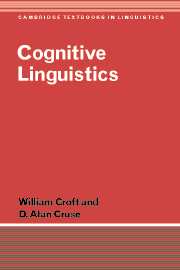Book contents
- Frontmatter
- Contents
- Figures
- Tables
- Preface
- 1 Introduction: what is cognitive linguistics?
- A conceptual approach to linguistic analysis
- Cognitive approaches to lexical semantics
- 5 Polysemy : the construal of sense boundaries
- 6 A dynamic construal approach to sense relations Ⅰ: hyponymy and meronymy
- 7 A dynamic construal approach to sense relations Ⅱ: antonymy and complementarity
- 8 Metaphor
- Cognitive approaches to grammatical form
- References
- Index
- Index
6 - A dynamic construal approach to sense relations Ⅰ: hyponymy and meronymy
Published online by Cambridge University Press: 05 June 2012
- Frontmatter
- Contents
- Figures
- Tables
- Preface
- 1 Introduction: what is cognitive linguistics?
- A conceptual approach to linguistic analysis
- Cognitive approaches to lexical semantics
- 5 Polysemy : the construal of sense boundaries
- 6 A dynamic construal approach to sense relations Ⅰ: hyponymy and meronymy
- 7 A dynamic construal approach to sense relations Ⅱ: antonymy and complementarity
- 8 Metaphor
- Cognitive approaches to grammatical form
- References
- Index
- Index
Summary
Sense relations such as hyponymy, incompatibility and antonymy have been a topic of lively interest for lexical semanticists since the structuralist period (see, for instance, Coseriu 1975; Geckeler 1971; Lyons 1963, 1968; Cruse 1986). Although Lyons (1968) declared that all sense relations were context dependent, they have almost universally been treated (including by Lyons himself) as stable properties of individual lexical items.
Cognitive linguists, for the most part, have had very little to say on the topic. In this chapter and the next, we reexamine a number of sense relations from the standpoint of the dynamic construal approach to meaning. Sense relations are treated as semantic relations not between words as such, but between particular contextual construals of words. We hope to show both that sense relations are a worthwhile object of study (even for cognitive linguists) and that the dynamic construal approach can throw new light on their nature. This chapter focuses on hyponymy and meronymy.
Hyponymy
Introductory
The following are examples of linguistic expressions whose semantic well-formedness depends on hyponymy (X is hyponymous to Y):
Xs are Ys (Koalas are marsupials)
Xs and other Ys (Koalas and other marsupials)
Of all Ys, I prefer Xs. (Of all fruit I prefer mangoes.)
Is it a Y?
Yes, it's an X. (Is it a tit? Yes, it's a coal-tit.)
There was a marvelous show of Ys: the Xs were particularly good. (There was a marvellous show of flowers: the roses were particularly good.)
- Type
- Chapter
- Information
- Cognitive Linguistics , pp. 141 - 163Publisher: Cambridge University PressPrint publication year: 2004



